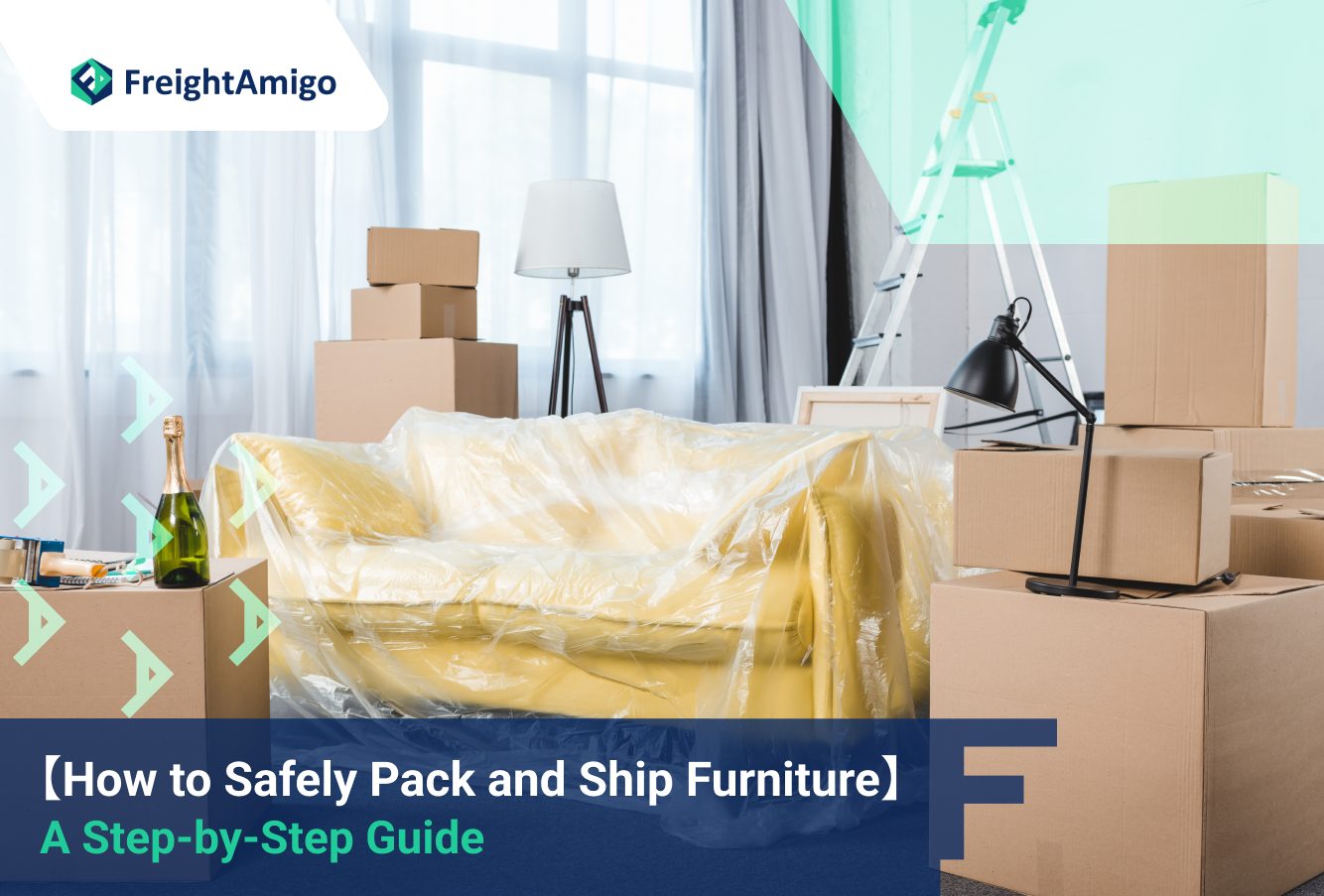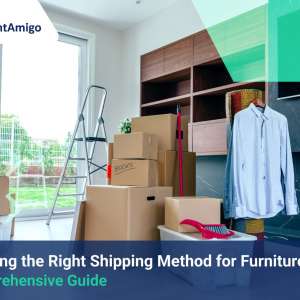How to Safely Pack and Ship Furniture: A Step-by-Step Guide
Latest update on 13 March, 2024 by Aurora Park – Marketing Analyst at FreightAmigo
If you are moving to a new home or shipping furniture for your business, it is important to know how to pack and ship your furniture properly. This will ensure that it arrives at its destination in the best possible condition. Shipping furniture can be complex, but with the right preparations, you can have a smooth and hassle-free experience.
This guide will provide a step-by-step process for packing and shipping furniture. We will cover everything you need to know to ensure the safe and secure transportation of your valuable items. This includes choosing the appropriate shipping method, as well as properly preparing and packaging your furniture.
Want To Compare The Best Express, Air Freight, Sea Freight, Rail Freight & Trucking Rates So As To Have Better Control On Cost?
Choosing the Right Shipping Method
When shipping furniture, there are two primary methods to consider: Less-than Container Load (LCL) shipping and Full Container Load (FCL) shipping.
LCL shipping is ideal for furniture shipments with a relatively low volume (between 2m3 and 13m3). It is a cost-effective option for smaller shipments that do not require a full container. For larger furniture shipments that exceed 14m3 or take up more than 10 pallets, FCL shipping is recommended. This method provides a dedicated container for your furniture, ensuring maximum protection and minimizing the risk of damage.
When choosing a shipping method, consider the volume and size of your furniture, as well as your budget and time constraints. If you are uncertain about which option is most suitable for your needs, seek advice from a shipping specialist who can offer guidance based on your specific requirements.
Preparing Furniture for Shipping
Before you start packing your furniture, it’s crucial to prepare it properly to ensure its safe transportation. This involves cleaning and disassembling any pieces that can be taken apart, securing fragile parts, and labeling and organizing everything.
Cleaning and Disassembling
Thoroughly clean your furniture before shipping to protect it from damage during transit. Dust and dirt can scratch or damage the surface, so wipe down each piece with a soft cloth or appropriate cleaning solution. Remove any removable parts, such as cushions or legs, and clean them separately.
Disassembling your furniture can also make it easier to transport and reduce the risk of damage. To make reassembly easier when your furniture arrives at its destination, dismantle any pieces that can be taken apart, such as tables, chairs, or bed frames. Store screws, knobs, and other small parts in labeled ziplock bags or small containers to keep track of them.
Securing Fragile Parts
During shipping, it is important to provide extra protection for fragile parts of your furniture, such as legs, arms, or delicate decorative elements. To do this, wrap these parts individually with padding, bubble wrap, or packing paper to create a cushioning layer that can absorb any impact during transit. It is important to follow these steps to ensure that your furniture arrives at its destination undamaged. For valuable or highly delicate items, consider using custom-built crates to provide an additional layer of protection.
When securing glass components, such as tabletops or mirrors, take special care. To prevent any movement or shattering during transportation, cover the glass surface with cardboard or foam wrap and secure it with packing tape.
Labeling and Organizing
Properly labeling and organizing your furniture is crucial for a smooth shipping process. You should clearly label each piece of furniture with your name, address, and contact information. This will ensure that your items are correctly delivered and make it easier to keep track of everything during the shipping process.
If you are shipping multiple pieces of furniture, consider numbering each item to indicate its sequential order in relation to the total number of boxes or pallets. This labeling system can help you stay organized and identify any missing items quickly.
Packing Materials and Tools
To pack your furniture safely, you’ll need a range of packing materials and tools. Here are some essential items to have on hand:
- Cardboard boxes in various sizes
- Packing tape to seal and secure boxes
- Bubble wrap for cushioning and protecting fragile items
- Packing paper or foam wrap for wrapping delicate parts
- Ziplock bags or small containers for storing screws and small parts
- Furniture blankets or moving pads for added protection
- Stretch wrap or shrink wrap for securing larger items
- Straps or bands to secure boxes and pallets
- Plywood sheets for creating a stable base on pallets
- Pallets for stacking and transporting multiple boxes
To prevent the introduction of foreign pests into the destination country, make sure that any wooden pallets or packaging material you use comply with ISPM 15 regulations. It is important to familiarize yourself with the specific regulations for wooden packaging materials in international trade to avoid any issues during customs clearance.
Wrapping and Cushioning
Once you have all the necessary packing materials and tools, it’s time to start wrapping and cushioning your furniture. This step is crucial for protecting your furniture from scratches, dents, and other damage during transit.
Start by wrapping fragile parts with bubble wrap or packing paper. Use additional padding or foam wrap for extra protection, ensuring that all edges and corners are covered. Secure the wrapping with packing tape to keep it in place.
Consider using furniture blankets or moving pads for larger items like sofas or mattresses. These thick, heavy-duty blankets provide extra cushioning and protection against bumps and impacts during transportation.
Box Selection and Packing Techniques
To ensure safe transportation of your furniture, it is essential to choose the right boxes. Opt for sturdy, double-walled cardboard boxes that can withstand the weight and size of your furniture. Reinforce the bottoms of the boxes with extra tape to provide additional strength and prevent them from breaking or collapsing.
When packing your furniture into the boxes, follow these techniques to maximize space and minimize movement:
- Place heavier items at the bottom and lighter items on top to maintain stability.
- Fill any empty spaces with packing material or padding to prevent shifting during transit.
- Stack smaller items within larger ones whenever possible to save space.
- Ensure that each box is not overfilled or underfilled. It should be packed tightly but not to the point of straining the box.
Securing and Sealing
To prevent accidental opening or damage during transit, it is essential to secure and seal your packed furniture. Seal all openings and seams of the boxes securely using packing tape. Apply multiple layers of tape to ensure it holds up throughout the shipping process.
For added security, consider wrapping the entire box several times with stretch wrap or shrink wrap. This provides an extra layer of protection against dust, moisture, and potential tampering.
Label each box with the shipper’s and consignee’s names and contact information. Include handling instructions such as ‘fragile’ or ‘this way up’ as necessary. It is important to note that some shipping carriers may charge higher rates for fragile items or have different insurance terms.
Loading and Transporting
To load and transport your packed furniture, you need to plan carefully and pay attention to detail. If you’re shipping your furniture on pallets, stack the boxes evenly to ensure weight distribution and stability. To prevent potential damage during handling and transportation, avoid overhangs or boxes jutting out beyond the perimeter of the pallets.
Use straps or bands to secure the boxes to the pallets, keeping them tightly in place. This prevents shifting or movement of the boxes during transit. Regularly inspect the straps to ensure they remain secure during transport.
When shipping furniture without pallets, load boxes into the shipping container or truck to maximize space and minimize movement. Fill any gaps with additional packing material or padding to prevent shifting during transportation.
Conclusion
Shipping furniture can be stress-free if you follow these step-by-step guidelines. By doing so, your furniture will arrive at its destination in the best possible condition. Ensure your furniture is properly packed and shipped by choosing the right shipping method, preparing it correctly, using appropriate packing materials and techniques, and securing and sealing your items. Proper planning and attention to detail ensure the safe transportation of your furniture to its new location. Freightamigo is your reliable partner when it comes to shipping furniture, offering comprehensive services and expert guidance to ensure a seamless and stress-free transportation process for your valuable items.
There Are Different Options For Cargo Transportation. If You Want To Choose The Most Convenient And Suitable Solution, It Is Best To Have The Full Support Of Logistics Experts! If You Are Planning To Import Furniture, Please Visit FreightAmigo Page For Inquiries.
Read More:
Furniture industry Import export trends, shipping information |FreightAmigo
How to Ship Nursery Furniture | FreightAmigo
Furniture Shipping | Guide for Long-Distance Shipping | FreightAmigo
If you have any inquiries on logistics/supply chain, feel free to contact FreightAmigo now:
Chat with us online | Hotline: +852 28121686 | WhatsApp: +852 27467829



